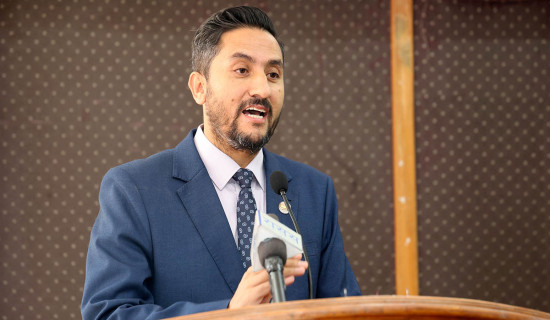- Wednesday, 17 December 2025
Scaling Up The TB-Free Initiative
Tuberculosis (TB) is one of the world’s deadliest infectious diseases. TB is caused by the bacillus Mycobacterium tuberculosis, which is spread when people who are sick with TB expel bacteria into the air. About a quarter of the global population is estimated to have been infected with TB. However, it is a preventable and curable disease.
Evidence suggests that TB continues to devastate millions globally, having adverse socio-economic and health impacts on individuals, families, and communities. It is a huge threat to human health. Therefore, the urgency of ending TB is a matter of concern in many developing countries.
Tackling the public health challenge of TB is not an easy task. According to WHO, 10.8 million people fell ill with TB in 2023, and 1.25 million people died of TB in the same year. However, the global efforts to end TB have been crucial to save the lives of millions affected by TB. Since 2000, about 79 million lives have been saved by these global efforts.
The global targets set in 2023 at the second high-level meeting on TB are relatively ambitious, which demands strong political leadership and commitments. In order to reach 90 per cent treatment coverage and TB preventive treatment coverage by 2027, a multi-sector approach to a comprehensive TB response must be a high-priority agenda for actions. Similarly, in order to reach 100 per cent coverage of the health and social benefits package for people with TB and rapid diagnostic testing for TB by 2027, additional resources must be mobilised to achieve these ambitious targets.
Despite significant public health challenges, Nepal has made notable progress in reducing the burden of TB over the decades. According to the global TB report 2024, Nepal accounts for an estimated 68000 people with TB and 16000 deaths in 2023. Three provinces, namely Madhesh, Bagmati, and Lumbini, contribute to 68 per cent of annual notifications. Data also reveals that the treatment success rate for Drug Susceptible TB (DS-TB) was 92 per cent and the death rate was 3.3 per cent.
Drug-resistant TB (DR-TB) continues to be a public health threat and is more challenging in terms of prevention, treatment, care, and support across the provinces. DR-TB was estimated to be 3000 in 2023. In the fiscal year (2023/24), there were a total of 756 DR-TB notifications, and 633 were enrolled in the treatment. More notably, while the death rate was 12 per cent, the treatment success rate was 78 per cent. Indeed, this is encouraging progress. However, TB-affected households face costs that are catastrophic. As per the first ever national TB patient cost survey (2023/24), the percentage of households facing catastrophic costs is 51 per cent.
The National TB Control Centre (NTCC) recently concluded its annual review of the TB programme together with representatives from provinces, local governments, technical partners, civil society organisations, the private sector, and experts to share the overall progress, identify key gaps, and determine the way forward for the next strategic plan to end TB. Apart from programmatic and operational issues, the review process also highlighted some cross-cutting issues such as social inclusion, equity, gender, and human rights in TB response. “So far, we have made good progress in the national TB response. But challenges still remain. From this annual review, we need to identify key strategic priorities for TB prevention, diagnosis, treatment, care, and support. With the leadership and commitment of federal, provincial, and local governments, we will be able to achieve the national targets in collaboration with technical partners, civil society, the private sector, and communities.” says Dr. Bikash Devkota, Secretary at the Ministry of Health and Population (MoHP).
While Nepal has a long history of TB response, enabling policies and strategic priorities are crucially needed for effective implementation of the national strategic plan. “Bold policies and political commitments are vital for meaningful community engagement and public-private partnerships, which can eventually help end the TB epidemic in the country,” said Dr. Dirgh Singh Bam, former Director at NTCC and Secretary, MoHP.
“We need to work more together to end the TB epidemic in Nepal. Multi-sector coordination and collaboration across the governments, civil society, partners, and private sectors are crucial to sustain the progress and achieve national targets. We need to integrate social protection, primary health care, and universal health coverage to realistically achieve the targets of health-related Sustainable Development Goals (SDGs),” says Dr. Shree Ram Tiwari, Director at NTCC.
As of now, the TB-free initiative is scaled up to 149 local levels, which is truly a government-led health system strengthening approach in ensuring a comprehensive TB response. This largely aims to enhance political leadership and commitments at the local level to accelerate the progress towards achieving the national targets. The strategic approach is to further strengthen the accountability of local governments, health facilities, health workers, health volunteers, community groups, the private sector, and other relevant stakeholders to reach out to poor and socially excluded people who are most vulnerable to TB.
“We are committed to ending TB in our municipality. Public awareness and capacity-building initiatives of local governments have been effective in reaching out to poor and socially excluded populations for their easy access to diagnosis, treatment, prevention, care, and support services in the communities. We have also allocated local resources to support the TB-free initiative as part of political accountability.” says Ramesh Budhathoki, Mayor of Hariwan Municipality, Sarlahi.
Considering strategic interventions, there are critical needs to continue and sustain intensified TB case finding and enhance quality treatment, care, and social protection support. More importantly, enhancing social accountability is vital to ensure effective multi-sector coordination and meaningful community engagement for TB response at all levels. While there are good practices of micro-planning for TB responses at the local level, more emphasis is needed to further strengthen the capacity of participatory monitoring and evaluation committees in reviewing the progress and addressing institutional bottlenecks at large.
“Our efforts to strengthen information systems at all levels will continue to ensure evidence-informed strategic interventions for sustained national TB response. We have developed a robust data management system with interoperability features and integrated with the national health management information system. Among others, research and innovation are also high priorities of the national TB response,” says Bir Rawal, Chief of Planning, Monitoring, Evaluation, Surveillance, and Research at NTCC.
While increasing focus on providing treatment and care largely remains on the health system, family members also play an important role in caring for a person with TB. “Community-based interventions need to promote engagement of family carers in supporting persons with TB in families and communities. This is an integral part of community system strengthening for TB response,” says Dr. Sushil Koirala, Country Representative at Noora Health.
Nepal still faces some programmatic gaps and operational issues to end the TB epidemic. Most notably, there is a significant funding gap. The current national strategic plan to end TB is 43 per cent underfunded. A similar gap is in the treatment coverage, which means 40 per cent in DS-TB and 75 per cent in DR-TB. Limited engagement of strategic partners within and beyond the health system also reveals inadequate resources available in TB prevention, treatment, care, and support. Because of resource constraints, there is still a challenge to ensure uninterrupted logistics, medicines, and other essential supplies across the provinces.
Moving forward, firstly, Nepal needs to adapt and institutionalise a multi-sectoral accountability framework that supports effective collaboration and accountability of governments and key stakeholders to end the TB epidemic by 2030. The framework essentially facilitates multisectoral action, mutual accountability, and measurement of progress towards commitments on TB at all levels.
Though there are initial discussions about this framework, NTCC needs to urgently take the lead in facilitating this process in coordination with key stakeholders within the health sector and beyond. Secondly, socio-cultural, economic, and political dimensions of TB must be addressed in scaling up the TB-free initiative at the local level. Thirdly, integration of services such as HIV, nutrition, mental health, and maternal and child health along with social and financial systems will greatly contribute to the sustainability of the national TB response.
(Bhandari is a health policy analyst interested in anthropology.)
















